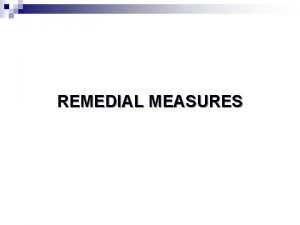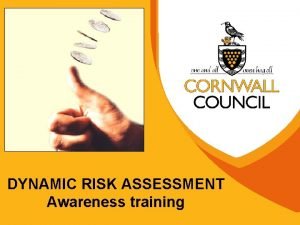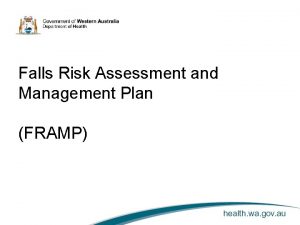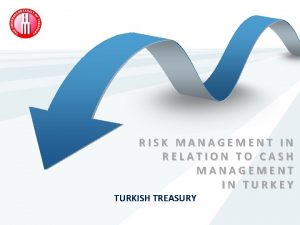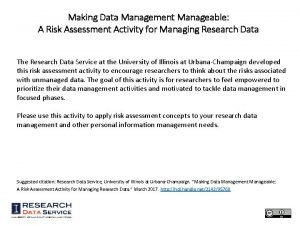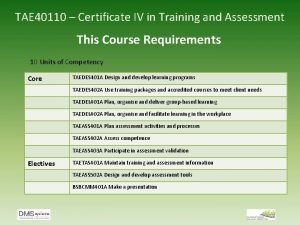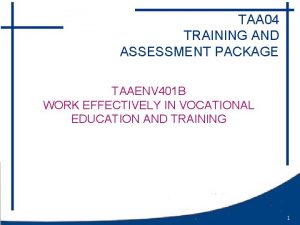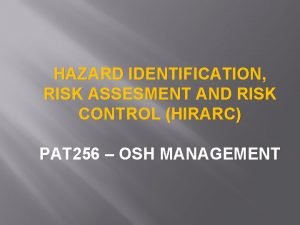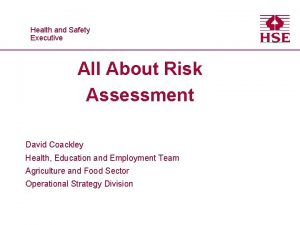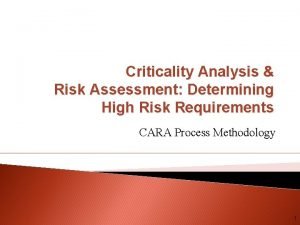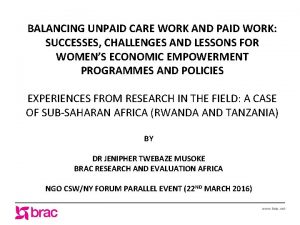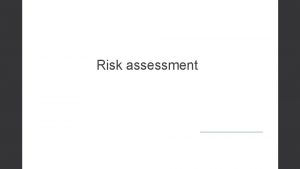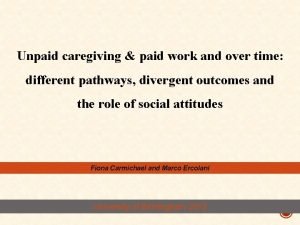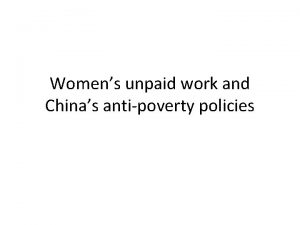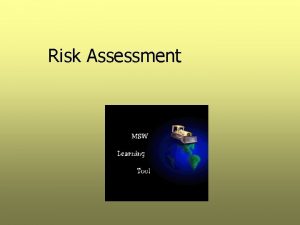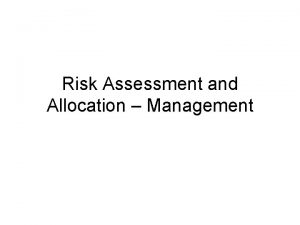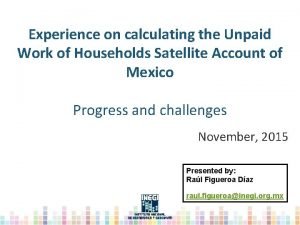Unpaid Work Risk Assessment and Risk Management Training




























- Slides: 28

Unpaid Work Risk Assessment and Risk Management Training Please use the arrows to move through the slides

Your Roles in Risk Assessment What is your role in Risk assessment? • Although OMs do the formal assessment of risk on an OASys, you are the eyes and ears of the service and are assessing risk constantly.

Your Roles in Risk Assessment What is your role in Risk assessment? • Because of this, it is important that we recognise and remember the risk issues that we should be looking out for and what to do with them if they arise.

We have a responsibility to be aware of each area of risk: Risk of re-offending It is critical to be and conviction aware of risk (Likelihood) issues Risk of harm (Impact) Risk of self harm highlighted in an OASys assessment for each service user

We have a responsibility to be aware of each area of risk: Risk of re-offending What and conviction behaviours are (Likelihood) we witnessing and what information are we hearing whilst out on work party? This information should either be passed on to the OM or, where there is an immediate risk to another, to the police

We have a responsibility to be aware of each area of risk: Risk of harm (Impact)

RISK OF SERIOUS HARM The OASys risk assessment tool defines 'serious harm' as: ‘a risk which is life threatening and/or traumatic and from which recovery, whether physical or psychological, can be expected to be difficult or impossible’ The Criminal Justice Act 2003 defines 'serious harm' as: 'death or serious injury whether that is physical or psychological'.

LEVELS OF RISK OF SERIOUS HARM IN OASys Very High Medium Low risk : There are no current indicators of a risk of serious harm Medium risk : There are indicators of a risk of serious harm but circumstances would have to change for that to take place

LEVELS OF RISK OF SERIOUS HARM IN OASys Very High Medium Low All cases are therefore assessed according to their likelihood to either kill someone or inflict serious harm from which recovery would be unlikely or very difficult.

MAIN RISK INDICATORS • Past behaviour and convictions • Motivation for and attitude towards offending • Access and proximity to victims Any behaviours (including grooming) or conversations about a risk • Preparedness to use weapons indicator need to be acted on, • Disinhibitors (alcohol and drugs) recorded and fed • Situational triggers back to OMs • Conditions and circumstances

MAIN RISK INDICATORS • Is there an immediate risk to the service user or another? – If so, what can we do to manage or reduce this risk, ie use of the police, moving the service user away from a risk situation, seeking to de-escalate tensions. – Whether resolved or not, all information needs to be shared with the offender manager as soon as possible

RISK OF HARM Concerned with: • Type (sexual, violent, other) • Nature (specific detail; use of weapons; specific victim targeted etc) • Harm caused (to the Victim(s) or property)

RISK of HARM When gathering and analysing information, including risk information – why do we need to consider the following? • Validity • Reliability • Sufficiency • Currency Evaluate all information, how reliable and how accurate is the information. Share all the information with the OM being clear about the source of that information.

RISK of HARM Don’t forget that risk is dynamic, this means that many factors associated to the assessed risk are changeable. This means that risk can either go up or down on a consistent basis.

DEFENSIBLE DECISIONS What are they?

DEFENSIBLE DECISIONS A decision is defensible if, in spite of a negative outcome it can be demonstrated that all: REASONABLE STEPS HAD BEEN TAKEN IN IT’S ASSESSMENT & MANAGEMENT

DEFENSIBLE DECISIONS • Ensure decisions are grounded in the evidence. • Use reliable risk assessment tools. • Collect, verify and thoroughly evaluate information. • Record and account for your decision making. • Communicate with relevant others, seek information you do not have. • Stay within agency policies and procedures

DEFENSIBLE DECISIONS • Match risk management interventions to risk factors. • Maintain contact with the offender at a level commensurate with the level of risk of harm. • Respond to escalating risk, deteriorating behaviour, and non-compliance. • Take all reasonable steps

BIAS & ERROR in RISK ASSESSMENT Errors in assessment can lead to: • false positives (over estimation of risk) or • false negatives (when we fail to recognise risks that do exist) Mistakes can arise from a number of causes: ØMissing or incomplete information. ØUsing data for limited populations ØVague, not reliable, or, current information.

BIAS & ERROR in RISK ASSESSMENT Errors in assessment can lead to: • false positives (over. Aestimation of risk) or lway eekto evaluwes sfail • false negatives (when risks to brecognise ate t e ob he in Be c jectiv form that do exist) arefu e an ati l ion a risk o of ov d v e a r colle under estimat ilable. aga ing th Mistakes can ariseshfrom of t i m uenumber a ting i e are a s to dis t. cu U nd re causes: cord ss and b se all in oth a f v o ØMissing or incompleteaiinformation. rmat lable ion. ØUsing data for limited populations ØVague, not reliable, or, current information.

BIAS & ERROR in RISK ASSESSMENT -cont • Bias and error Ø It’s seen through research that the longer someone works with an offender, the less reliable their assessment of risk becomes because we can often assume the best of those we know well. Ø Equally, we all have unconscious biases and can assume the worst of someone because of our own prejudices. Question your assessment and guard against either form of bias

RISK ASSESSMENT IS CONTINUOUS. . It is important to always be… • open to new info and assimilating it ( so what does this mean ? ) • checking out our assumptions • aware of bias and errors • maintaining a “healthy scepticism” • open to new information • reviewed & reassessed if risk increases or gives cause for concern.

We have a responsibility to be aware of each area of risk: Risk of self harm

SELF HARM • The term 'deliberate self-harm' is generally used to cover all acts of self-harm, self-injury or attempted suicide. • Acts of deliberate self-harm and suicide attempts do not necessarily involve an intention to die.

RISK PREDICTION “A history of past suicide attempts is the most accurate predictor of future risk of suicide” Look at the OASys assessment and determine whethere is a history of self harm or suicide.

SELF HARM • As with all risk, act on immediate risks, and pass all information on to the OM in the first instance unless there is an immediate risk that needs to be reported to the police. • Don’t leave any risk issue, of any kind, unresolved. Pass all information on and agree actions, contact managers or an on call ACO out of office hours.

SELF HARM • As with all risk, act on immediate risks, and pass all information on to the OM in the first instance unless there is an immediate risk that needs to be reported to the police. • Don’t leave any risk issue, of any kind, unresolved. Pass all information on and agree actions, contact managers or an on call ACO out of office hours.

You have now completed the UPW Risk e-Learning
 Section 7-2 finance charge answers
Section 7-2 finance charge answers Unpaid seller section 45
Unpaid seller section 45 Unpaid voucher file
Unpaid voucher file What is unpaid advertising
What is unpaid advertising How do the twelve tables resolve unpaid debts
How do the twelve tables resolve unpaid debts Introduction of unpaid seller
Introduction of unpaid seller Dynamic risk assessment training
Dynamic risk assessment training What is framp
What is framp Population health risk assessment and management
Population health risk assessment and management Liquidity measures
Liquidity measures Cash management risks
Cash management risks Contract management risk assessment matrix
Contract management risk assessment matrix Data management risk assessment
Data management risk assessment Contract management risk assessment matrix
Contract management risk assessment matrix Key risk indicators template
Key risk indicators template Risk map risk management
Risk map risk management Section 4 review physical science
Section 4 review physical science Tae40110 certificate iv in training and assessment
Tae40110 certificate iv in training and assessment Taa04
Taa04 Hirarc full form
Hirarc full form Health and safety risk assessment template
Health and safety risk assessment template Criticality analysis and risk assessment
Criticality analysis and risk assessment Smart vs hard working
Smart vs hard working Physics 03-06 impulse and momentum answer key
Physics 03-06 impulse and momentum answer key Residual risk and secondary risk pmp
Residual risk and secondary risk pmp Business vs financial risk
Business vs financial risk Relative risk calculation
Relative risk calculation Attributable risk (ar)
Attributable risk (ar) Features and principles of portfolio assessment
Features and principles of portfolio assessment

